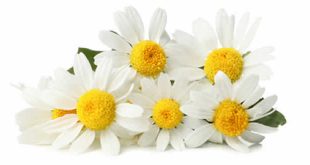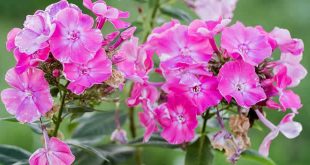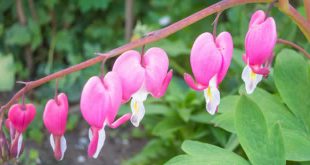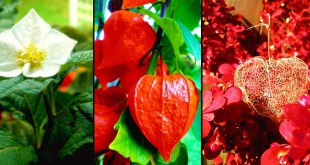Kingdom: Plantae Family: Asteraceae Order: Asterales Genus: Bellis Daisy: Bellis perennis — is the common name for many different members of the composite family, Compositae. The name originally referred to the English daisy, Bellis perennis, a Eurasian perennial seldom exceeding 15 cm (6 in) in height. Its flowers have yellow centers and white or rose outer petals. In the United …
Read More »Phlox: Flower Encyclopedia
Kingdom: Plantae Family: Polemoniaceae Order: Ericales Genus: Phlox Phlox Flower — Phlox (pronounced “flocks” and meaning ‘flame’ in Latin) is a genus of 67 species of annual or perennial flowering plants. Some species flower in early spring while others flower in summer into fall. Most species are native to temperate North America but a few species are also from northeastern …
Read More »Bleeding Heart: Dicentra – Ornamental Plant
Kingdom: Plantae Family: Papaveraceae Tribe: Fumarieae Genus: Dicentra Bleeding Heart — Dicentra is a genus of about 20 species of herbaceous flowering plants in the family Fumariaceae, native to Asia and North America. The common name, bleeding heart, is used for many of the species. This name comes from the appearance of the pink flower, which resembles the shape of …
Read More »Chinese Lantern Plant: Herbaceous Perennial
Kingdom: Plantae Family: Solanaceae Order: Solanales Genus: Physalis Chinese Lantern Plant — Chinese Lantern Plant, common name for a herbaceous perennial (a plant that lives at least three years) grown in gardens for its showy fruit. It is native to southeastern Europe and Japan and can survive winter temperatures as low as -40° C (-40° F). In colder regions, it …
Read More »Yucca
Yucca — The yuccas comprise the genus Yucca of 40-50 species of perennials, shrubs, and trees in the agave family Agavaceae, notable for their rosettes of evergreen, tough, sword-shaped leaves and large terminal clusters of white or whitish flowers. They are native to the hot and dry parts of North America, Central America, and the West Indies. Yuccas have a …
Read More »Wisteria
Wisteria — Wisteria is a genus of about ten species of woody climbing vines native to the eastern United States and the East Asian states of China, Korea, and Japan. Aquarists refer to the species Hygrophila difformis, in the genus Hygrophila, as Water Wisteria. Wisteria vines climb by twining their stems either clockwise or counter-clockwise round any available support. They …
Read More »Wintergreen
Wintergreen — Wintergreen is a group of plants. Wintergreen once commonly referred to plants that continue photosynthesis (remain green) throughout the winter. The term evergreen is now more commonly used for this characteristic. Some species of the shrub genus Gaultheria in the closely related family Ericaceae also demonstrate this characteristic and are called wintergreens in North America, the most common …
Read More »Water Lily
Water Lily — Water lily is the common name for more than 40 species of aquatic plants of the water lily family, Nymphaeceae. Some species are known as LOTUSES. Found throughout temperate and tropical regions, water lilies are characterized by large, nearly circular, leathery floating leaves and by white, yellow, pink, red, scarlet, blue, or purple flowers that float or …
Read More »Water Hyacinth
Water Hyacinth — The seven species of water hyacinths comprise the genus Eichhornia of free-floating perennial aquatic plants native to tropical South America. With broad, thick and glossy ovate leaves, water hyacinths may rise some 1 metre in height. The leaves are 10-20 cm across, supported above the water surface by long, spongy and bulbous stalks. The feathery, freely hanging …
Read More »Violet
Violet — Viola, commonly called Violets, is a genus of flowering plants in the family Violaceae, with around 400-500 species distributed around the world. Most species are found in the temperate Northern Hemisphere, however viola species are also found in widely divergent areas such as Hawaii, Australasia, and the Andes in South America. Most viola species are small perennial plants, …
Read More » Kids Portal For Parents India Kids Network
Kids Portal For Parents India Kids Network



